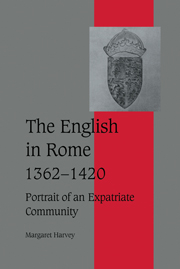Book contents
- Frontmatter
- Contents
- Acknowledgements
- List of abbreviations
- Maps
- Introduction
- 1 The setting I: Rome in the later fourteenth century, 1362–1376
- 2 The setting II: Rome, 1376–1420
- 3 S Thomas's hospice
- 4 S Chrysogonus' hospice and other enterprises
- 5 The laity in Rome
- 6 Women
- 7 The English in the curia 1378–1420: I
- 8 The English in the curia 1378–1420: II
- 9 The career of John Fraunceys
- 10 Adam Easton, an English cardinal: his career
- 11 Adam Easton's ideas and their sources
- 12 Conclusion
- Bibliography
- Index
- Cambridge Studies in Medieval Life and Thought Fourth Series
10 - Adam Easton, an English cardinal: his career
Published online by Cambridge University Press: 28 July 2009
- Frontmatter
- Contents
- Acknowledgements
- List of abbreviations
- Maps
- Introduction
- 1 The setting I: Rome in the later fourteenth century, 1362–1376
- 2 The setting II: Rome, 1376–1420
- 3 S Thomas's hospice
- 4 S Chrysogonus' hospice and other enterprises
- 5 The laity in Rome
- 6 Women
- 7 The English in the curia 1378–1420: I
- 8 The English in the curia 1378–1420: II
- 9 The career of John Fraunceys
- 10 Adam Easton, an English cardinal: his career
- 11 Adam Easton's ideas and their sources
- 12 Conclusion
- Bibliography
- Index
- Cambridge Studies in Medieval Life and Thought Fourth Series
Summary
Adam Easton was the last Englishman to become a cardinal resident at the curia for about one hundred years. His career is therefore of great interest; he was a scholar rather than a politician, but both his rise to position and his subsequent career tell us a great deal about the curia in his day, particularly its cultural climate.
Easton owed his success to his own intelligence and to the notice of Simon Langham. He was probably born about 1330 (in 1378 he described himself as ‘more than forty years old’) and probably came from Easton in Norfolk, since the majority of Norwich monks, as Easton became, were from the Norfolk estates of the priory. We do not know when he entered the priory but 1348 would be a good guess. Promising young monks like this, thought likely to rise in the monastery, were for some years sent to Oxford, where young Adam read theology. We first hear of him there in 1352, when Bishop Bateman tried to recall him and another monk with books and plate from the convent. It is not now clear what was going on, but Easton protested saying he had appealed to the pope. Whatever the trouble he stayed in Oxford.
We know little about his student days. Thomas de Brinton, later a well-known preacher and bishop, with a distinguished career in Rome, was a contemporary.
- Type
- Chapter
- Information
- The English in Rome, 1362–1420Portrait of an Expatriate Community, pp. 188 - 212Publisher: Cambridge University PressPrint publication year: 2000



